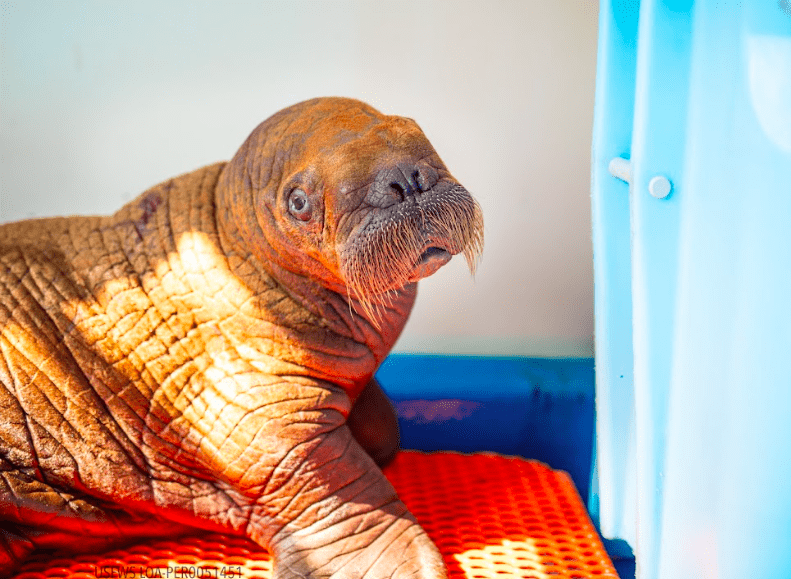
Seward, Alaska (August 3, 2023) – The Alaska SeaLife Center (ASLC) is caring for a male Pacific walrus calf that arrived from the North Slope of Alaska on August 1, 2023. This is the Center’s first walrus patient in four years, and one of only ten admitted in the Center’s 25-year history, making this an exceptional case for the Wildlife Response Program and a rare opportunity for all involved.
The young walrus was spotted by workers on Alaska’s North Slope, about four miles inland from the Beaufort Sea — a highly unusual location for Pacific walrus, which reside almost exclusively in the ocean or near the western coastline. Observers reported a notable “walrus trail” on the tundra close to a road where he was discovered, although it is unknown how he arrived inland. Walrus calves depend on maternal care for their first two years of life, and with no adults in the vicinity, it was apparent that the wayward calf would not survive long without intervention.
With U.S. Fish and Wildlife Service approval, the ASLC coordinated with Alaska Clean Seas and ConocoPhillips Alaska to provide shelter and arrange travel. The calf was moved to a warehouse, and teams kept a watchful eye on him overnight. ConocoPhillips Alaska graciously offered the use of one of the company’s planes for transport. Staff from both organizations then flew with the calf to the Seward Airport to meet with the ASLC team.
The transport team landed safely at the Seward Airport around 3 p.m. on August 1. The nearly 200 pound calf (estimated to be around a month old) was carefully moved into the ASLC Wildlife Response van, and brought under the care of an experienced ASLC wildlife response team. After an initial exam, the main concerns found by the veterinary team were malnutrition, dehydration, and a cloudy eye. Initial bloodwork confirmed that the calf was dehydrated, and suggested that he may be fighting an infection.
ASLC staff is currently following a 24-hour care regimen, which is more demanding than many other marine mammals require. Walruses are highly tactile and social animals, receiving near-constant care from their mothers during the first two years of life. To emulate this maternal closeness, round-the-clock “cuddling” is being provided to ensure the calf remains calm and develops in a healthy manner. Calves tend to habituate quickly to human care, and staff report that he is already eating formula from a bottle.
“We are lucky that his first night went well,” said ASLC Wildlife Response Curator Jane Belovarac. “It isn’t often that we’re able to admit a walrus calf, but every time we do, we learn more about the species and how to care for them.”
Though the walrus calf cannot currently be viewed publicly, he may be relocated to an area with limited public viewing as his condition improves. Upon such a development, the ASLC will send out additional announcements.
It takes a community to organize successful rescues like this one, and the ASLC is grateful to both Alaska Clean Seas and ConocoPhillips Alaska for guaranteeing the calf’s swift arrival and for going above and beyond to provide safety and comfort during his first night’s stay. Alaska Clean Seas has been an active Oiled Wildlife Response Partner with the ASLC since 2010, and ConocoPhillips has been a major supporter of the Center for many years.
“ConocoPhillips is honored that we were able to assist with the rescue and transportation of the young walrus,” said Erec Isaacson, President, ConocoPhillips Alaska. “This is an example of a network of caring neighbors who work together for the best possible outcomes. Alaska is fortunate to have an organization like the Alaska SeaLife Center where patients can be cared for by veterinary professionals. He is in great hands, and we look forward to following his story.”
